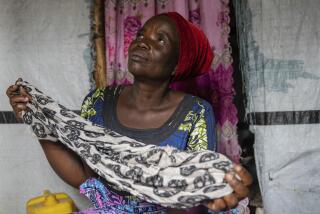Hunger Sets Up Camp Among Sudanese Driven Out by Militias
- Share via
DARFUR, Sudan — At 2 years old she has never walked, and her wrists are as thin as her mother’s little finger, but when the child, Insaf, reached slowly to pull the feeding cup to her lips on Monday afternoon, her mother smiled with joy and relief. It meant Insaf might live.
Every time her mother, Fatima Isher, took the cup away, the child’s hand fluttered to bring it back, and her mother beamed. Two days ago, Insaf Dawalbeit would take no food, but in the Nyala Hospital emergency feeding center Monday, she drank every drop of the milky solution provided for severely malnourished children.
The week before, another mother from the same displaced persons camp of Otash, outside the city of Nyala in Sudan’s South Darfur region, lay on a similar bed watching her son struggle unsuccessfully for life.
The child, Mohammed Mahjoub, was about the same age as Insaf, and his skin hung loose on his frame. His mother, Kaltum Hamid, 23, looked on in despair as his breathing turned to slow panting, and his eyes turned upward.
“I saw that he was dying. I couldn’t watch, because my heart could not take it. I just sat outside the room and wept,” she recalled. “He was my first child. I remember the day he was born. I was so happy.”
Hamid’s husband was seized by fighters in the Arab militias known by their victims as janjaweed, who attacked their South Darfur village of Donki early one morning in May. She believes he is dead.
More than 1.2 million people have fled their villages because of attacks by the militias, and 30,000 to 50,000 are estimated to have died. In recent months, nearly half the refugees did not have food, international officials say.
“I lie awake at night and I can’t sleep. I feel I am all alone, missing my husband and missing my child,” Hamid said.
Mohammed was buried in the cemetery at the edge of Otash camp, among dozens of forlorn, unmarked graves.
Hamid is trying to be strong. She stood at his grave Sunday, her palms turned to the skies in prayer. Then she turned and wiped away a tear.
“I just asked God to give me another child,” she said.
The first distribution of emergency food for malnourished children at Otash arrived Monday, too late for Mohammed.
Otash is one of several camps that have sprung up around Darfur, and until now it had no general food distribution.
Some people have sought to survive on wild plants, and others, like Hadiya Dawsa, a mother of five looking after her baby in the Nyala feeding center Monday, have sent their children out to beg for food. Some camp dwellers weave grass mats to sell in Nyala for a handful of flour.
In the 10 days since the World Vision children’s clinic began working in Otash, it has registered 232 malnutrition cases and transferred 118 to the Nyala emergency feeding center. The center, run by CARE, has admitted 170 people since it opened in July, and 34 of them have died.
There are no official mortality and child malnutrition rate figures for Otash, or Darfur in general, officials say.
But a camp leader at Otash, Abdulkarim Adam Eeka, said 72 children and 85 adults -- including 21 women giving birth -- had died there in the last three months.
World Vision said it planned a general distribution of food at Otash in coming days. It had registered about 17,000 people in the camp.
About 200 malnourished children received emergency rations at the camp Monday.
“Last night my children could not sleep,” Eeka said. “They were crying and shouting, ‘Father, give me food!’ I am suffering too. I am a human being, but there is no way for me to feed my children.”
Mothers who came Monday to collect rations for their children received advice that tore at their hearts. They were not allowed to share the emergency food with their other children.
“My other children are also sick, but I didn’t bring them here,” said one mother, Ruhiya Adam Abaker, 24, with a malnourished 2-year-old girl. “They are hungry because we have no food. And I need some food for myself also. This is not enough.”
The rooms at the Nyala feeding center were almost silent. Two mothers and their gaunt children shared each bed.
The children lay listlessly, barely moving. Parents gently dripped feeding solution into their mouths using syringes.
One of the frailest children was an 18-month-old girl, Mastura Ismail, the youngest of 12 children. She was hollow-eyed, her skin stretched over protruding cheekbones. She could not move her arms or legs.
When her mother, Hadiya Rahma Adam, tried to pour a little rehydration fluid into her mouth, her tiny face screwed up in distaste. An hour later, she took a few drops from a syringe.
By evening she was sleeping under a cover. Her mother said she seemed a little better.
More to Read
Sign up for Essential California
The most important California stories and recommendations in your inbox every morning.
You may occasionally receive promotional content from the Los Angeles Times.










